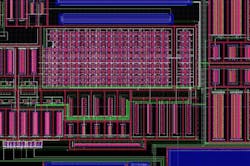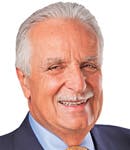Q&A: An Interview with Kaufman Award Winner Dr. Lucio Lanza
Lucio Lanza has been a stalwart supporter of the EDA and IP business, investing in early-stage companies or advising entrepreneurs with little or no fanfare. Few individuals in the electronics industry are as admired as Dr. Lanza. The news release announcing that he is this year’s Phil Kaufman Award recipient perhaps says it best: In recognition of his advancement of the EDA and IP industry through his generous business and technical mentoring, and financial support of numerous innovative companies, the EDA Consortium and IEEE Council on EDA are pleased to present the 2014 Phil Kaufman Award to Dr. Lucio Lanza.
Wong: Congratulations! How does it feel to be 2014’s recipient of the Phil Kaufman Award?
Lanza: It feels great and I’m very, very grateful. It’s especially moving for me because Phil Kaufman and I were colleagues at Intel.
This file type includes high resolution graphics and schematics when applicable.
Wong: Please tell Electronic Design readers a bit about Phil Kaufman.
Lanza: Phil Kaufman was CEO of Quickturn Systems and Silicon Compilers, both early EDA companies. He died unexpectedly while on business for Quickturn in Japan in 1992. Before either of those startups, Phil ran the microprocessor division at Intel and I was in charge of strategy for the microprocessor division. If you’re thinking, “Wow,” I need to tell you the entire story. At the time, microprocessors were not seen as overwhelming. Memories, PCB offerings, and development systems were considered more promising than microprocessors. And, my role was not strategist, but to make sure the Intel strategy for the microprocessor was being defined and implemented. Phil, however, was an exceptional strategist. Intel’s dominance in microprocessors is a credit to Phil Kaufman’s vision. He and I worked closely for many years and I admired him.
Wong: What technology would you invest in that you do not see on the horizon? What technology areas are of interest to you?
Lanza: I see two areas. The Internet of Things will influence the expansion of analog design and that could breed a whole new wave of startups. IoT challenges are much more formidable than we may realize. Analog designers need different tools and a different way of doing design.
The other is the area between software and the SoC, or what I call no man’s land. No one is addressing the needs in the middle or the design layer. It’s like the wilderness where no one goes. It’s untouched and fertile ground.
An interesting area to watch involves software startups looking at machine learning for design automation. Machine learning is helping make Moore’s Law continue to change to meet the next challenges coming in the silicon evolution. Several emerging startups are building a fundamental platform with easier access that will become the systems of the future. They will change the way humans interact with the computer. This is design automation.
Wong: What is your perspective on the EDA industry and the electronics industry?
Lanza: My view is that the semiconductor disruption is happening and we cannot stop the future. EDA is under the disruption and is impacted by the laws of silicon. The EDA industry has to change what it’s designing now and in the future.
The industry often overlooks the fact that EDA and IP are part of one another. IP was pioneered by ARM and Artisan Components. They changed the model and created value for which they were compensated. Library companies were only selling licenses. With ARM and Artisan, they became IP companies providing value. IP redefined EDA.
Wong: How should EDA change?
Lanza: If someone tells me EDA is slowing down, I believe they’re slowing down, not EDA. I’m optimistic about the infinite opportunities for EDA to innovate. For example, EDA should help software developers who are developing chips. As I mentioned earlier, no one’s working at the middle between software and the SoC, an area that’s quickly developing into the design layer. It’s as modularized as the SoC itself.
Think about it one step at a time. The chip in XX years from now may be designed in 3D with the same concept as a skyscraper of yesterday or today. It will be simple layers with a central post for all utilities. The way data is stored and managed will be transformed. We’ll move from horizontal design to vertical design. One design will become a platform. Because everything is a plane, all layers could be different. No tools today can support this type of design. It will be so much more complex and built in a modular fashion. We’ll need both the methodologies and tools to manage the complexity of the next computer as we move from horizontal design to vertical design. EDA will acquire dimensions.
Wong: What overall trends are you seeing in the electronics industry?
Lanza: Moore’s Law is Moore’s Law and EDA has accepted the challenge. The evolution of Moore’s Law derives the challenge to provide an environment that allows time for design and keeps costs under control. EDA accepted the challenge and has been building the methodologies and tools to meet the challenge in spite of the significant increases in complexity due to Moore’s Law.
This file type includes high resolution graphics and schematics when applicable.
We will see the transformation of fabless semiconductor companies into virtual integrated device manufacturers (IDMs) driven by big data. The complexity of design is such that it requires specialized characteristics in manufacturing. The management of manufacturing data and capabilities for significantly different applications will be another big challenge.
About the Author
William G. Wong
Senior Content Director - Electronic Design and Microwaves & RF
I am Editor of Electronic Design focusing on embedded, software, and systems. As Senior Content Director, I also manage Microwaves & RF and I work with a great team of editors to provide engineers, programmers, developers and technical managers with interesting and useful articles and videos on a regular basis. Check out our free newsletters to see the latest content.
You can send press releases for new products for possible coverage on the website. I am also interested in receiving contributed articles for publishing on our website. Use our template and send to me along with a signed release form.
Check out my blog, AltEmbedded on Electronic Design, as well as his latest articles on this site that are listed below.
You can visit my social media via these links:
- AltEmbedded on Electronic Design
- Bill Wong on Facebook
- @AltEmbedded on Twitter
- Bill Wong on LinkedIn
I earned a Bachelor of Electrical Engineering at the Georgia Institute of Technology and a Masters in Computer Science from Rutgers University. I still do a bit of programming using everything from C and C++ to Rust and Ada/SPARK. I do a bit of PHP programming for Drupal websites. I have posted a few Drupal modules.
I still get a hand on software and electronic hardware. Some of this can be found on our Kit Close-Up video series. You can also see me on many of our TechXchange Talk videos. I am interested in a range of projects from robotics to artificial intelligence.
Dr. Lucio Lanza
Managing Director, Lanza techVentures; Chairman of the Board, PDF Solutions
Dr. Lucio Lanza, the 2014 recipient of the Phil Kaufman Award for Distinguished Contributions to the electronic design automation (EDA) industry. Dr. Lanza, a noted investor in early-stage EDA, IP and semiconductor companies has been a part of the Silicon Valley fabric since he left Olivetti Corporation in Italy after 10 years (1968-1977) to join Intel in 1977. He is being recognized with the Phil Kaufman Award from the EDA Consortium and IEEE Council for EDA (CEDA) for his substantial impact on EDA through his strategic and financial assistance to innovative EDA companies.
Early in his career, he held positions of increasing responsibility for strategy and innovation at Intel, including chairman of the microprocessor Strategic Business Segment (SBS). Dr. Lanza moved to Daisy Systems Corp, an early EDA company, where he served as vice president of marketing and later as general manager of the EDA division. From 1986 to 1989, he was chief executive officer of EDA Systems, Inc. After EDA Systems was acquired by DEC, he became an independent consultant to companies in the electronics, communications and EDA industries from 1990 to 1995, including Cadence Design Systems. Simultaneously, he served as a venture partner and a general partner at U.S. Venture Partners (USVP) from 1990-2000.
Currently, in addition to being managing director of Lanza techVentures, he is chairman of the board of PDF Solutions, a position he’s held since 2004, and serves on the board of directors of several private companies. He holds a doctorate in electronic engineering from Politecnico of Milano.



